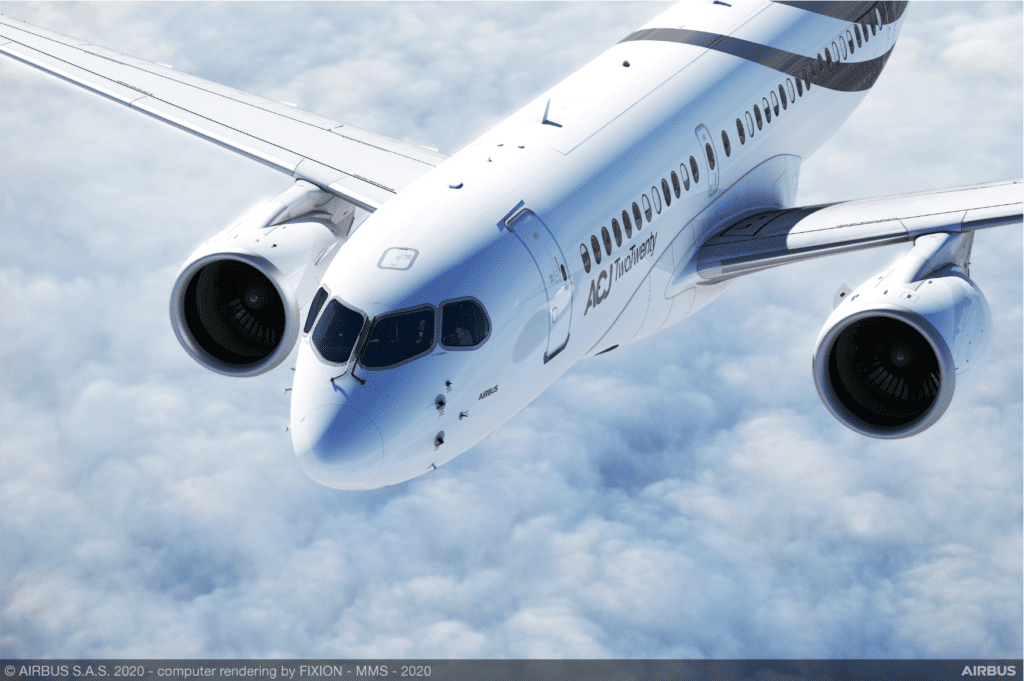
“The innovative solution [the ACJ TwoTwenty) combines intercontinental range and up to three times more personal space, thus providing more comfort for each passenger and at a similar price tag as ULR bizjets but with a much lower operating cost,” says Sean McGeough, VP Commercial Airbus Corporate Jets for North America. (Photo: Airbus)
Airbus Corporate Jets launched the TwoTwenty corporate jet aircraft at the end of 2020.
In a conversation with Avionics International, Sean McGeough, VP Commercial Airbus Corporate Jets for North America, remarked that this aircraft allows the company to compete in the ultra-long-range aircraft market. The first TwoTwenty is set to be delivered in the first quarter of 2023, he shared.
The TwoTwenty was designed to be competitive in terms of price and operational costs while having the same footprint as others in its category. “This is an opportunity to build market share around the world,” McGeough said.
He noted that the value proposition of Airbus Corporate Jets’ (ACJ) TwoTwenty aircraft is its cabin. The ACJ TwoTwenty offers twice as much square footage as other ultra-long-range jets, he commented.
“The innovative solution combines intercontinental range and up to three times more personal space, thus providing more comfort for each passenger and at a similar price tag as ULR bizjets but with a much lower operating cost,” McGeough remarked in the press release by Airbus.
The aircraft is built with advanced avionics, McGeough told Avionics—”It’s the same avionics suite you find in some of the ultra-long-range jets.” The engines on the TwoTwenty are built to be very fuel efficient, he added, and the airframe incorporates the latest composites and alloys.
McGeough remarked that the business aviation industry has been very resilient during the COVID-19 pandemic. “We’ve been very fortunate,” he said. “Although there are some storm clouds ahead, we’ve already proven that we can sustain and still grow.”
He listed some of the reasons for the growth of the business aviation market in the U.S.—“a significant increase in new ‘first-time’ users of business aircraft during the worst of the COVID-19 crisis who now want to continue flying privately; employers placing a growing focus on the well-being of their managers; [and] new innovative aircraft being launched that have a greater focus on efficiency and sustainability.”

A rendering of the ACJ TwoTwenty in flight (Photo: Airbus)
He also commented in detail on the importance of sustainability at Airbus. “A lot of customers are very conscious of how these aircraft impact the environment,” he said. “Right now, 50% of all Airbus products—including helicopters, commercial airliners, et cetera—can use sustainable aviation fuel. By 2030, we want to make it 100%.”
Sustainable aviation fuel, or SAF, can reduce CO2 emissions by as much as 80%. Beginning in January of this year, Airbus has used SAF to deliver all aircraft produced at its Mobile, Alabama facility.
The longer-term goal for Airbus is reaching zero emissions by 2035. The entire aviation industry is aiming to achieve net zero emissions by 2050.

Pictured above is the cockpit of an ACJ TwoTwenty aircraft. (Photo: Airbus)
According to McGeough, Airbus invests $2 billion every year on research and development. Much of this investment goes towards new engine variants and electric and hydrogen technologies.
ACJ also shared in its recent announcement about the TwoTwenty that Comlux Completion, a service center in Indianapolis, will become an approved Service Center MRO for the ACJ TwoTwenty. Comlux will be capable of performing all necessary maintenance, refurbishing the cabin, and handling system upgrades.